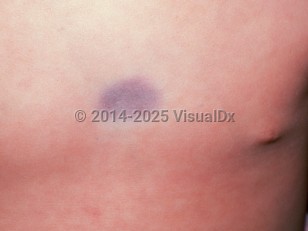Cutaneous arteriovenous malformation in Adult
Alerts and Notices
Important News & Links
Synopsis

Arteriovenous malformations (AVMs) are vascular anomalies where arterial and venous systems connect directly to each other, bypassing venules, arterioles, and capillaries. They are considered fast-flow anomalies with a direct connection between arteries and veins, compared to venous malformations, which are slow-flow anomalies.
AVMs most frequently occur in the intracranial circulation, in the pelvis, and extremities. Cutaneous AVMs are rarer. They typically present on the head and neck area and are often present at birth (40%), although they may not be clinically evident until later in childhood, or progressive growth may occur during puberty or pregnancy.
The majority of AVMs are sporadic. They are sometimes associated with a somatic mutation in the KRAS gene. AVMs may also be a manifestation of various syndromes, including Parkes-Weber syndrome, Cobb syndrome, capillary malformation (CM)-AVM, syndrome, and hereditary hemorrhagic telangiectasia syndrome (pulmonary, gastrointestinal, and intracranial AVMs). Underlying AVMs may also exist in the port-wine stains of adults that have developed a hypertrophic or nodular component.
AVMs may continue to enlarge over time, causing disfigurement or pain. Ulceration, infection, and hemorrhage are local complications. High-output cardiac failure is a systemic complication that may occur with extensive AVMs.
AVMs most frequently occur in the intracranial circulation, in the pelvis, and extremities. Cutaneous AVMs are rarer. They typically present on the head and neck area and are often present at birth (40%), although they may not be clinically evident until later in childhood, or progressive growth may occur during puberty or pregnancy.
The majority of AVMs are sporadic. They are sometimes associated with a somatic mutation in the KRAS gene. AVMs may also be a manifestation of various syndromes, including Parkes-Weber syndrome, Cobb syndrome, capillary malformation (CM)-AVM, syndrome, and hereditary hemorrhagic telangiectasia syndrome (pulmonary, gastrointestinal, and intracranial AVMs). Underlying AVMs may also exist in the port-wine stains of adults that have developed a hypertrophic or nodular component.
AVMs may continue to enlarge over time, causing disfigurement or pain. Ulceration, infection, and hemorrhage are local complications. High-output cardiac failure is a systemic complication that may occur with extensive AVMs.
Codes
ICD10CM:
Q27.30 – Arteriovenous malformation, site unspecified
SNOMEDCT:
254780006 – Arteriovenous malformation of skin
Q27.30 – Arteriovenous malformation, site unspecified
SNOMEDCT:
254780006 – Arteriovenous malformation of skin
Look For
Subscription Required
Diagnostic Pearls
Subscription Required
Differential Diagnosis & Pitfalls

To perform a comparison, select diagnoses from the classic differential
Subscription Required
Best Tests
Subscription Required
Management Pearls
Subscription Required
Therapy
Subscription Required
References
Subscription Required
Last Reviewed:09/10/2023
Last Updated:09/19/2023
Last Updated:09/19/2023
Cutaneous arteriovenous malformation in Adult

